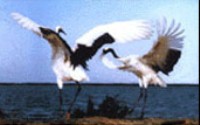 From a thatched cottage, 34-year old Wang Hui observed a family of red-crowned cranes. Only about 2,200 of the creatures are in existence and they are listed as the most endangered birds on earth by the World Conservation Union (IUCN).
From a thatched cottage, 34-year old Wang Hui observed a family of red-crowned cranes. Only about 2,200 of the creatures are in existence and they are listed as the most endangered birds on earth by the World Conservation Union (IUCN).
The Yancheng Biosphere Reserve in east China’s Jiangsu Province has the country’s largest original coastal wetland, which covers more than 3,000 square km.
The reserve is now the best winter habitat for the cranes. Before the Tang Dynasty (618-907), the cranes could be seen in the middle and lower reaches of the Yangtze River. But because of dwindling habitats, their number has been shrinking over the years.
To preserve the wetland for the cranes, a group of young environmental workers have devoted themselves to working in the Yancheng reserve.
“This one comes from Zhalong Nature Reserve in northeast China’s Heilongjiang Province, and that one is from Siberia in Russia,” said Wang Hui, referring to two workers feeding cranes in the distance.
He himself is a graduate of the Agriculture University in northeast China’s Jilin Province and has been working at the Yancheng reserve for 12 years. After researching the region’s environment, the existing habitat of the cranes and the social and economic conditions of the reserve Wang wrote the thesis “Managing the Habitat of Red-Crowned Cranes with GIS (Global Information System),” which gained him an award for young scientists from the United Nations Science and Cultural Organization.
While more than 1,000 of the cranes spent last winter at Yancheng, only 615 have been spotted this winter. “Something must have happened in the breeding regions,” said Wang. “The biggest enemies of the cranes are humans.”
The red-crowned cranes, which are migrating birds, gather in Yancheng and nearby areas every winter after long journeys from northeast China, Russia, Mongolia and the Korean Peninsula. Anything that happens to these places or along the travel routes leads to a reduction of the crane population.
Having successfully bred 19 red-crowned cranes, Chen Guoyuan, who also works there, is an expert on the rare bird.
“Every year, farmers send us wounded cranes that they find. The birds are very clever, some of them visit us the next year after we have made them better."
Gao Zhidong has been working at the reserve for three years after graduating from the Jiangsu Agriculture University. His research topic is to breed red-crowned cranes there to enlarge the population.
“In 1998 we hatched nine crane chicks and only four survived. But we are confident that the numbers will increase greatly in another three or five years,” said Gao.
The young man his now used to the barren wetlands far away from the city. “Our efforts are very meaningful,” he said. “And we will let more people realize the importance of the relationship between red-crowned cranes and mankind via the Internet.”
Every visitor to the Yancheng Reserve sees a marble statue of a girl. In 1987, Xu Xiujuan drawned while looking for two missing swans.
The death of the 23-year-old environmental worker motivated local people to join in the efforts to protect the birds and other wildlife in the region.
But Wang Hui said there is still a long way to go in the protection of the red-crowned cranes. Last year, a dozen of them were poisoned when poachers laid out poisonous bait for wild ducks.
Wang said that in Japan, the red-crowned cranes seldom leave their breeding place because they have a good habitat and the Japanese do a lot of environmental protection work.
“Protecting red-crowned cranes is also to protect humans, as the extinction of one species will threaten the existence of scores of others,” said Wang.
(China Daily 02/07/2001)
